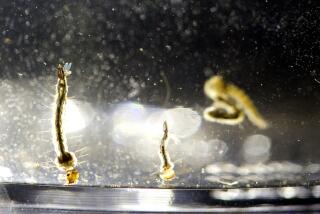Team makes species into another
- Share via
Biologists have converted one species of bacterium into another by replacing all of its DNA, a critical step toward their ultimate goal of designing entire organisms from scratch, according to a study published Thursday.
The transplanted DNA took over its single-cell host in about three days. The resulting bacterium was indistinguishable from the donor species, the researchers reported in the online edition of the journal Science.
“This is the equivalent of changing a Macintosh computer to a PC by inserting a new piece of software,” said J. Craig Venter, a maverick geneticist and senior author of the study.
Venter’s team intends soon to apply the technique to a string of genes assembled in a laboratory and bring to life a simple creature that has never existed before.
Eventually the scientists hope to create tiny genetic factories for churning out environmentally friendly fuels and chewing up unwanted carbon dioxide.
In the burgeoning field of synthetic biology, “this is an important development,” said bioengineer Jay D. Keasling of UC Berkeley and the Lawrence Berkeley National Laboratory.
With this tool in hand, “anybody should be able to construct bacterial cells from scratch,” said Drew Endy, a biological engineer at MIT.
Venter, who famously challenged the decade-long effort by federal scientists to decode the human genome by completing the feat at a private company in just two years, said the DNA transplants had so far worked only in two closely related bacterium species.
He and his colleagues at the J. Craig Venter Institute in Rockville, Md., cautioned that it would take time to figure out the recipes for transferring genomes between other organisms.
In the study, the researchers removed intact DNA from Mycoplasma mycoides and inserted it into Mycoplasma capricolum. Both bacteria cause respiratory disease and other ailments in goats. They were chosen for the experiments because they have relatively small genomes and grow rapidly, allowing scientists to gather data in a matter of days.
The team inserted a gene for resistance to the antibiotic tetracycline into the donor bacterium before removing its DNA. They then mixed the naked DNA with the host bacterium and exposed it to tetracycline, which killed off any bacteria that lacked the antibiotic-resistance gene. After a few days, the surviving organisms contained only the donor DNA.
To confirm that the genome transplant was complete, the researchers checked to see whether the DNA had instructed the cells to produce the same proteins as the donor bacterium. They had. The team also looked for evidence of genes unique to the host bacterium and couldn’t find them.
“It’s amazing that one genome replaces another,” said Andrew Ellington, a biochemist at the University of Texas at Austin. “I don’t know of a comparable method whereby one could kick-start an entire genome.”
The procedure is reminiscent of somatic cell nuclear transfer, the method used to clone Dolly the sheep and other animals. In that process, scientists remove the entire cell nucleus from an unfertilized egg and replace it with the nucleus from the animal to be cloned.
In some ways, transplanting naked DNA is a more remarkable achievement than transplanting an entire cell nucleus, Ellington said.
“In a sheep, what you’re doing is nuclear transfer -- sending in all the machinery ready to roll,” he said. “Here, you just send in the blueprint.”
Researchers at the Venter Institute are simultaneously trying to create a blueprint for a self-replicating creature using as few genes as possible. Their synthetic genome is based on another Mycoplasma bacterium, and they hope it will be similar enough to transplant into the same host used in this experiment.
But as synthetic biologists design more complex genomes, the technique may need significant adjustments, said study coauthor Clyde A. Hutchison III of the Venter Institute.
“We don’t have any idea yet really how widely applicable this would be,” said Hutchison, who is also a professor emeritus of microbiology and immunology at the University of North Carolina at Chapel Hill.
The process also needs to get more efficient, since only one bacterium out of every 150,000 takes up the foreign DNA.
“We think we can improve this,” said coauthor John I. Glass of the Venter Institute.
Venter has high hopes for the nascent technology. In 2005, he founded a company to develop totally synthetic environmental remediation microbes and microbes to produce alternative fuels. That company, called Synthetic Genomics, funded the study published in Science.
“He’s actually quite concerned about global warming and dependency on petroleum and the whole way we make things happen via energy,” said UC Berkeley anthropologist Paul Rabinow, who studies the business of molecular biology and genetics.
In other ventures, Venter hunts for new genes in microbes living in ocean waters and New York City air. Those genes may become building blocks for future synthetic species.
“He’s trying to imitate things that go on in nature and in evolution, but at a very accelerated rate,” Rabinow said.
--







